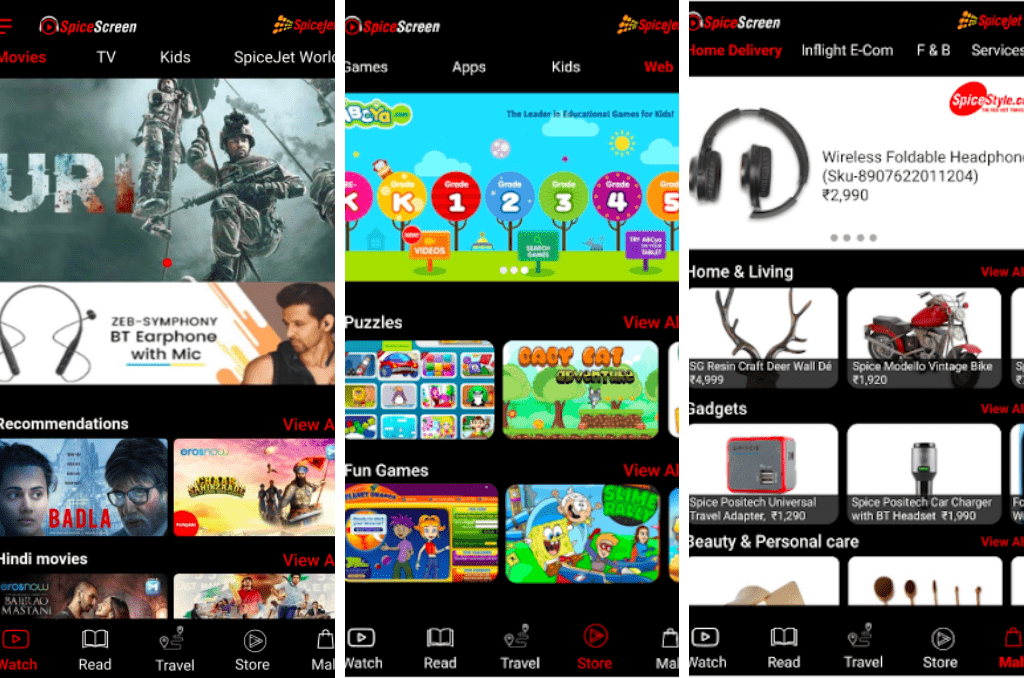VuLiv’s Smartphone-Based IFE System Powers SpiceJet’s Revamped Offering
Share

Indian startup VuLiv is challenging the idea that in-flight entertainment (IFE) servers are always clunky. SpiceScreen, SpiceJet’s revamped IFE system, is powered by a pair of VuLiv’s specially-formatted Android smartphones. It costs the airline 1% of what it was paying its previous service provider.
Atmanirbhar Bharat. The phrase, coined by Indian prime minister Narendra Modi while announcing a coronavirus economic relief package, literally translates to “self-reliant India.” The idea is not so much about protectionism and isolation as it is about strengthening local initiatives and bolstering the nation’s economic standing on the world stage.
VuLiv is an Indian startup that takes this ethos to heart. Its Android smartphone-turned-IFE streamer, VuScreen, is a made-in-India solution. With some modification, a mid-tier phone can be transformed into a router/media hub hybrid that can serve content to 40 passengers simultaneously. The resulting IFE solution is lightweight, intuitive and features a long battery life. On August 10, SpiceJet announced its new SpiceScreen IFE offering would be powered by VuScreen. “This is yet another step in our journey towards a stronger and a more Aatma Nirbhar airline,” said Ajay Singh, the carrier’s chairman and managing director.
Manoj Gupta, founder and CEO at VuLiv, said inspiration struck during a tour of the 2018 APEX EXPO exhibition hall. He saw nothing but “big bulky routers” that weighed around 20 pounds each, equipped with batteries lasting no more than 10-12 hours. He also found the licensing fees that airlines were expected to pay exorbitant. VuLiv’s research and development team, already well-versed in travel Wi-Fi solutions catering to rail, metro and bus passengers, spent over a year developing VuScreen in response. Receiving EMC, EASA and Indian aviation clearances required another year.
SpiceScreen is powered by two VuScreen-enabled smartphones that weigh 180 grams each. Under optimal conditions, the battery can last two days on a single charge. In the spirit of Atmanirbhar, the 100 gigabytes of content stored on each phone is also provided by VuLiv. The company has strategic relationships with content production houses and digital content partners such as Mzaalo, and has access to over 10,000 movies, TV shows, children’s programming and regional content across a variety of genres. Across the two smartphones, the grand total of content is 400 hours, served up in 8 languages.
VuLiv’s grand vision for IFE, however, goes beyond just serving content to passengers. The company positions itself as an ecosystem partner and is keen on digitizing many aspects of the in-flight experience. Using the VuScreen app pre-flight, passengers can book tickets and pre-order meals, as well as book ground transportation and hotels via third-party APIs. During their journey, they can summon flight attendants, enjoy free seat-to-seat chat and shop. VuScreen supports advertising, offering a source of ancillary revenue for airlines, and delivers analytics reports to airlines so they can further refine the service.
Making VuScreen even more appealing these days is the contactless nature of the offering. With so many functions delegated to the passenger’s personal device, touchpoints like shopping catalogs and IFE screens are eliminated, and contact with crew is reduced, thus lowering the probability of spreading COVID-19.
Gupta calls it “unbelievable” that the digital e-commerce revolution happening on the ground is not being more widely replicated at 35,000 feet. Thanks to the homespun ingenuity displayed by VuLiv, airlines around the world can take advantage of a small and mighty solution courtesy of a small-but-mighty company.


